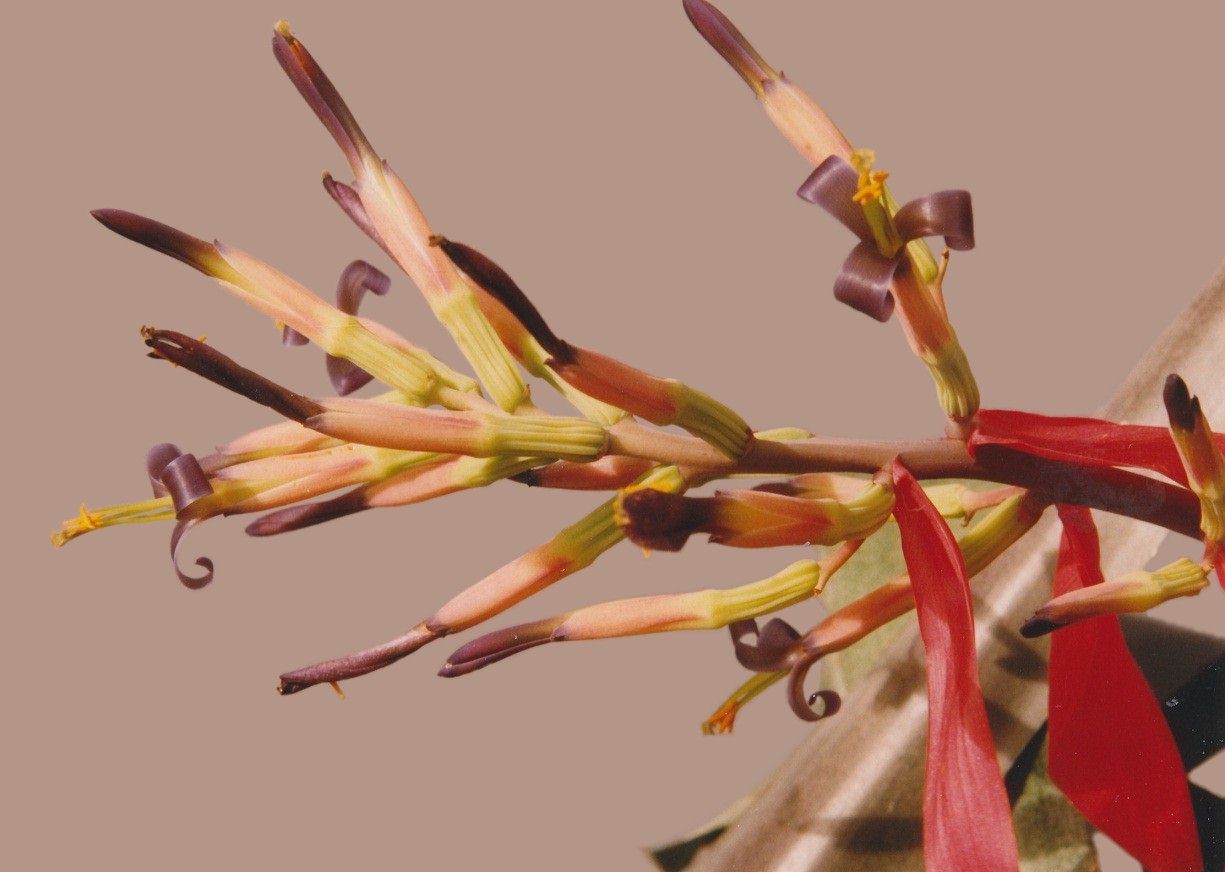
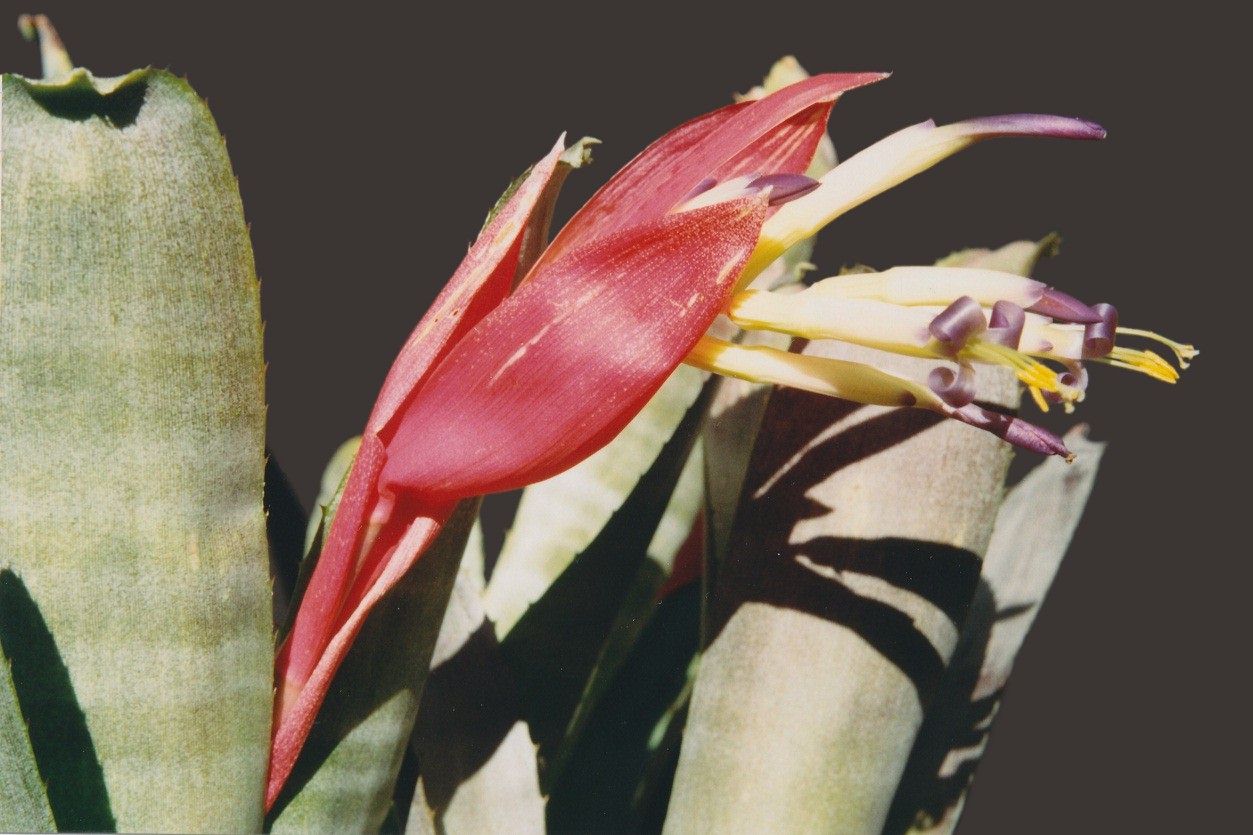
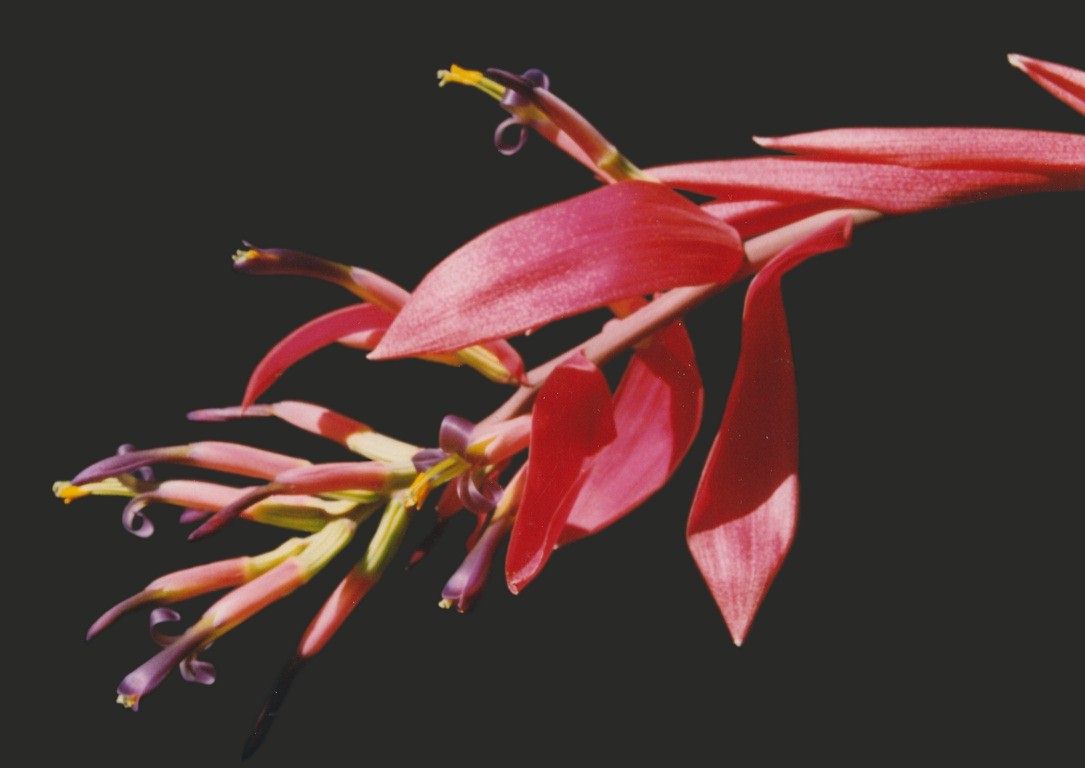
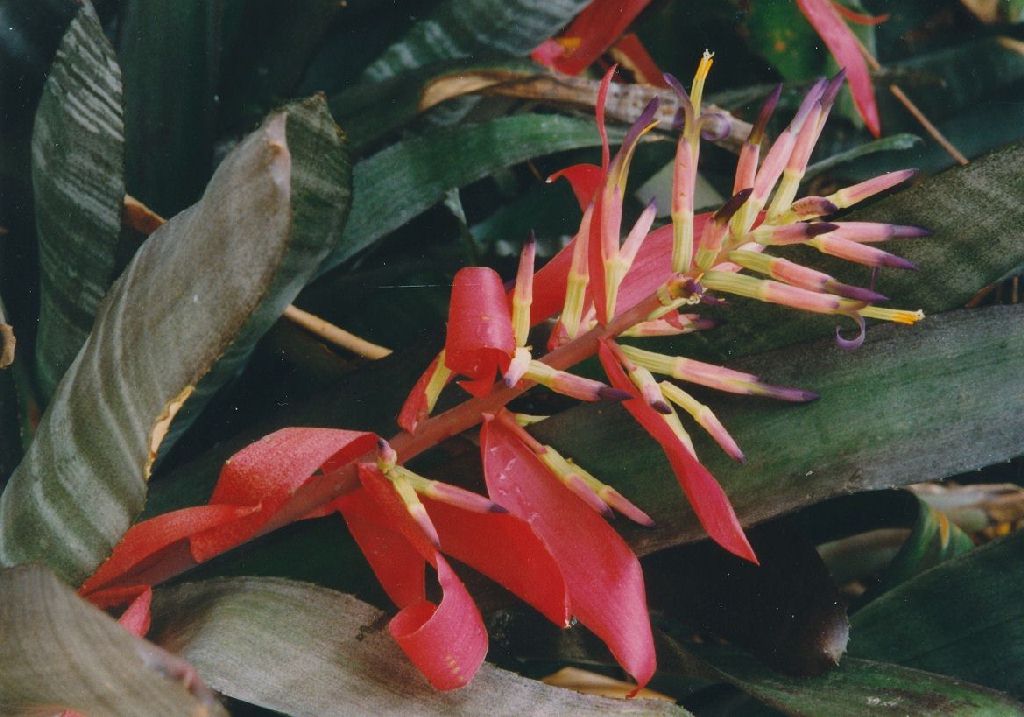
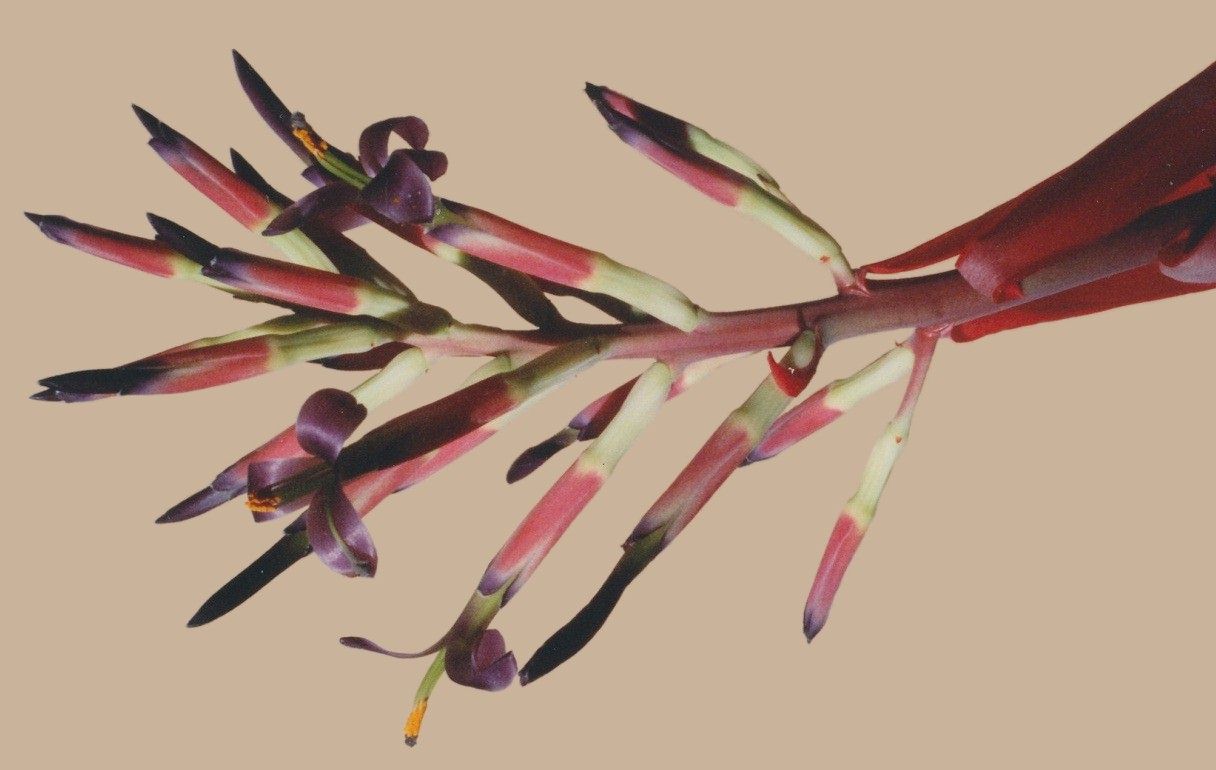
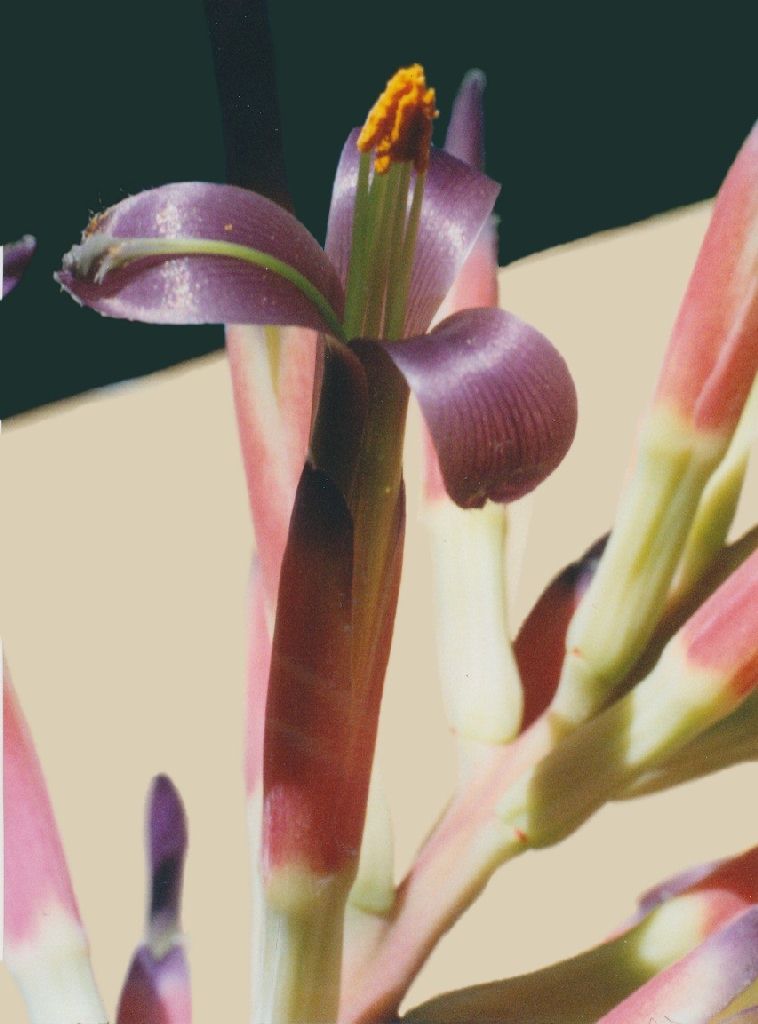
First let me say that there are not many Billbergia species being grown in Australia but there are lots and lots of hybrids. Many of the watchspring species are self fertile and there appears to be less hybridization with these but even so it is not easy to identify the various species. On the other hand the other group are rarely self fertile but are easily hybridised. Just one example is the over use of B. vittata and there are many plants in collections which are almost the species but not quite. If the label is lost my first thought is B. 'Chas Webb' (or should it be?)
I have had Baker's Handbook of the Bromeliaceae (printed in 1889) for many years, & have referred to it from time to time to check on old names. It was only very recently that I realised he also described hybrids, but only Billbergia. I still find this strange and can only assume that the reason is the ease with which these species hybridize.
Billbergia vittata and B. nutans were favourites. So it was a surprise to find a description of B. x Breauteana which I had been looking for in all manner of places, but not the right one.
The description was:
Billbergia BREAUTEANA Andre (vittata x Bakeri) Synonym CAPPEI
Leaves - 10-12 in a rosette, lorate, obtuse, horny, 60cm or more long, 5-6cm wide at the middle, copiously banded with white at the back, the marginal prickles minute.
Scape - over 30cm long with several large bright red bracts towards the top.
Inflorescence - a lax drooping panicle, the lower branches 3-4 flowered, subtended by large red bracts.
Sepals - linear oblong, 2.5cm long, pinkish white tipped with violet.
Petals - twice as long as the sepals, bright violet-blue.
Ovary - cylindrical, pale green, deeply sulcate, 2cm long.
This cross, which was made by M. Andre in France, has been distributed by M. Bruant of Poitiers, and I think also by someone in Belgium. Described from a plant that flowered at Kew, Dec. 1886. Billbergia x collevii, x oberthueri, x joliboisii and x rhedonensis are similar hybrids between speciosa & vittata, raised by Van Geert (see De Vos in Belg Hort 1882, 334) and B. herbaultii hort., another raised by Maron.
To add to the information (confusion?), I noted there was very little difference in this description and that given for B. vittata. The differences do show up when you consider B. vittata sensu Lyman Smith and Elton Leme.
Let us have a change of direction and look at the Australian scene (in the meantime you might like to check your B. 'Chas Webb' against the above description!)
Bromeletter Nov/Dec 1972 - by Olwen Ferris....
"Billbergia vittata x ? (pyramidalis var. concolor). A very hardy hybrid and one of the best for growing out of doors in a lightly shaded area. While not as tall as B. vittata it has silver bands on green leaves forming a loose tube with arching leaf tips and in bright light the leaves take on a purplish colour. Flowering at various times in the summer it has a B. vittata type inflorescence of rose-red bracts and blue flowers.
This hybrid is in many collections under the name "B. amoena hybrid", while a similar plant but winter flowering, and with a slightly tighter, taller tube, is given the name "B. horrid hybrid". I think it is possible that these two plants are clones from the same cross. Being unable to see any resemblance to B. amoena in the first plant I selfed this in 1965. The seedlings have the shape of a loosely formed but larger B. pyramidalis var. concolor with faint banding on the leaves. The flower head arches slightly with the weight of over 20 tightly packed blue flowers above a collar of large rose-red bracts on the inflorescence, the first of these to flower showing the influence of both parents."
Bromeletter Sept/Oct 1974. The following article by Robert Tucker is an interesting one because it clearly has links with our problem. Mind you it adds problems too, because I am aware of the reference to the first four paragraphs, but then the description of the flower baffles me. Is he talking about two plants?
"A BEAUTIFUL BILLBERGIA" - by Robert Tucker.
Most members would probably have had more experience with bromeliads than I have and would be able to put names to plants that I have not yet seen, so perhaps someone will recognise this Billbergia (pictured) and be able to give me some clue as to its identity. This was the second plant to be added to the beginning of my collection about six years ago, it has flourished ever since. It was in my home-town of Blackwood (S.A.) where I found it in some quantity, generally growing in the open ground in full sun. It would form thick clumps in any spot and in winter it would take frost and hail without damage.
The opposite conditions, and Adelaide's heat-waves and dry winds are extreme and did not damage it either.
I have not seen it since in any other collection or garden and think that it might be common only in S.A., but as it was not to be seen at the well kept and very beautiful Adelaide Botanic Gardens, and I knew no collectors there, I found nothing regarding its name or history. There was one plant similar to it at the Gardens, but it had a pendant spike and was not labelled.
About the plant; tubes would average at around 22 inches tall; taller and shorter plants could be found but never much smaller than 12 inches or taller than 30 inches. In shade the leaves would vary from 18 to 22 inches and 12 to 18 inches in full sun. Coloration would vary too in different light, being very dark green in shade to bronzy red in full sun. The mature plant would form a sort of vase-like tube of stiff short leaves in sun or tall tube of long and flat leaves in shade where the silvery-qrey banding would stand out the most and last until the eventual death of the plant. Strong sun seemed to bleach out the banding and very hot days would yellow the leaves although they would not burn.
In the ink-drawing I have the dark bands to represent the green of the leaf in one of my shade grown plants, the light bands being the actual greyish banding that was faintly visible on the top of the leaf. I would have darkened in the top-side of the leaf but feel that this would have made the picture too dark. This specimen is about half grown and only 5 months from a minute pup. It would measure 14 inches in height.
About the flower; The inflorescence is more erect than not and has a simple construction. Bracts are vivid pink to red with a covering of white scales that is also present on the stem. Flowers number between 10 & 15 and have white sepals and blue tipped green petals. The inflorescence lasts only a week and sits about 8-10 inches above the centre of the plant but is cradled by the leaves. The pollen is brilliant yellow & the anthers really stand out because of this.
I have grown this as Billbergia horrid but this is clearly not correct as it does not have the stiff leaves and prominent spines of horrid but the spines are evenly spaced along the margins and are quite sharp. It does have a sort of erect inflorescence like horrida but differs in colour of petals. It resembles my B. amoena hybrid (B. amoena var viridis x B. amoena var rubra) in shape and foliage texture and might be the type but as I have never seen either the type plant or the flower I cannot say. In fact I cannot say if it is even a hybrid as I have never hand pollinated it. I can say that it will not set seed on its own as some do, and I will probably have to self it when its next spike appears to see if it is a hybrid.
I would appreciate any answers or hints that you might have regarding this fine and hardy plant. Thank-you. "
There are many clumps of tall tubular billbergias still growing in older gardens around the Adelaide hills including Blackwood and a large property by the name of "Weetunga" bequeathed to the Adelaide Botanic Gardens some 15 years ago. It also occurs in the Adelaide foothills where some of the old properties are being subdivided. How do I know this?
Well, these billbergias look so good when in flower that residents believe they have a fortune to be made, telephone the Botanic garden and eventually get to me. It doesn't take much questioning to ascertain the type of plant they are talking about and they are always surprised how common it is and its market value!! It just has to be Billbergia ‘Chas Webb’!
The name Billbergia ‘Chas Webb’ originated in 1982 when I was compiling my Checklist of Australian hybrids and Olwen Ferris felt that her plant Billbergia vittata x pyramidalis (refer Bromeletter Nov/Dec 1972 see above) needed a name. Charles Webb from Sydney was one of the pioneers of Bromeliad growing in Australia and although not a hybridist seemed to be a logical name to use for this robust Billbergia. This way his name would be remembered.
In 1993, when preparing for the Adelaide Conference, I saw the botanical painting of B. Breauteana in the Adelaide Botanic Gardens which I thought looked like OUR B. ‘Chas Webb’. Because of Robert Tucker's article and the phone calls about unnamed billbergias I was getting, I felt that this plant must have originated in Adelaide & then spread eastwards. I wrote, sending details to Bill Morris who said he had had this plant as long as 1955 and that it had been seen in the public Gardens at Port Macquarie well before that. This put paid to my theory. He then added that he did not feel the other parent was B. pyramidalis & that Olwen could have been talking about another plant. He had never seen seed on "OUR" plant and I could confirm this. AND remember billbergias hybridise easily so you cannot always assume selfing has occurred.
Doubts, doubts and more doubts. Let us return to Baker's description and the names associated with parentage. Let us also remember that hybrids are made from living material where people do not change names when botanists tell them to do so! So we are dealing in suppositions! Billbergia Bakeri became synonymous with B. distachia but Baker said that B. Cappei was synonymous with B. Breauteana and yet its formula was vittata x amoena. He also said that this cross was similar to those of Van Geert who surprisingly got 4 different names by crossing two species namely speciosa (now amoena) and vittata.
AND things get worse. The fact that B. Bakeri became B. distachia had me looking at Leme's natural hybrid B. x claudioi whose alleged parents are B. vittata and B. distachia. You've guessed it - Leme's description is almost identical to that given for ‘Breauteana’! Has anyone imported B. x claudioi as a plant? Please let me know if you have.
What did I gain from this exercise? Well, a much clearer picture of what B. vittata should look like. First the leaves must have decent sized very-dark teeth but the flower should be like this....
Note - (1) The sepal tip is bent outwards - not erect.
- (2) The base of the ovary has a pinkish floral bract, smallish but clearly visible.
I have found this continuing story fascinating because it has given me a better understanding of what these hybrids should look like. There is only one thing really bugging me and that is why B. ‘Collevii’ never flowers for me and looks like a straight B. amoena!
BILLBERGIA 'Chas Webb' and vittata - by Bill Morris N.S.W. in Bromeletter 34(3); 9. 1996
I read Derek's article in the last Bromeletter with some interest and would like to make some comments.
The plant now called 'Chas Webb' was one of the first bromeliads I got, around 1955. An old cactus grower in Newcastle was growing it as a terrestrial amongst his cacti. It was a large clump so probably had been in his garden at least back to World War II (10 years earlier). This suggests it was probably in Australia at least in the 1930's which means it is an early European hybrid rather than anything later.
Looking at the plant I have never seen any resemblance to Billbergia pyramidalis, and as Derek mentioned in his article, I have never been able to self it. This makes me suspect that the seed Olwen obtained may have come from chance pollination by B. pyramidalis even though she believed she had selfed it. However, this cannot be checked until someone can repeat Olwen's experiment.
I have always suspected it was a Billbergia vittata – amoena cross. If one considers how variable B. amoena is, and the fact we have no idea which form of amoena was used, there doesn't have to be a great resemblance to any other hybrid of this parentage. Although we think we know B. vittata, reading Smith and Downs' description indicates it is very variable also. For example, the description says: "leaves rounded & apiculate or broadly acute, scape erect (!) or decurved, slender or rather stout, scape bracts red, rose, or orange (mine is orange), inflorescence often erect (!)". Also the colour photo in Elton Leme's book, p.101, shows a B. vittata which is quite unlike my plant in many ways.
As we don't know what type of B. vittata was grown in Europe and used as a parent we really are in no position to make too many accurate comparisons.
As Derek said, "And things get worse".
Apparently Baker listed B. breauteana (a possible identification of our Chas Webb) as B. vittata x B. bakeri with the latter now reduced to synonomy with B. distachia. So I consulted Smith and Downs to find that they list B. breauteana as B. vittata x amoena.
So where are we? Well, in my opinion, and that's all any of us can offer, B. ‘Chas Webb’ has general characteristics that suggest a B. vittata x amoena parentage, and as Smith & Downs list B. ‘Breauteana’ as B. vittata x amoena, I will settle on that as the best bet. However, due to the great variability of both parents ‘Chas Webb’ is almost certainly not identical to B. ‘Breauteana’ as depicted in the Adelaide Gardens painting and ‘Chas Webb’ should be treated as a cultivar. That is, B. Breauteana (?) c.v. Chas Webb.
Now a final word about B. vittata. Derek provided a sketch of a flower taken from Smith & Downs and said…
"Note 1. The sepal tip is bent outward, not erect". Now the description doesn't mention this! So I don't think this is important. And when one looks at the other flowers illustrated (B. of fig.687, p.1982) the side views do not show the sepal tips at right angles to the tube (as shown in C. same fig.). If in fact the sepal tips did recurve as shown in fig.C, Smith & Downs did not consider it important or consistent enough to be included in the description. Thus I would disagree with Derek and say that this illustrated character is not important in the identification of B. vittata.
To finally confuse the issue further, Smith & Downs list the following names for the cross of vittata and amoena:
breauteana – 1884, joliboisii – 1882, cappei – 1889, oberthueri – 1882, collevei – 1882, rhedonensis – 1882, herbaultii – 1889, wittmackiana - 1891
So which name has precedence for this hybrid (grex)? Presumably the others become cultivars.
BILLBERGIA 'Breauteana' by Andre, Revue Hort. 56. 117.1884
Thanks to Jason Grant who obtained a photocopy. Translated by D.Butcher.
Plant stemless, offsetting from an early age.
Leaves wrinkled with parchment finish, not leathery, ascending-curved, strap shaped, faintly channelled, the edges with fine distant teeth, blunt at the top with a reflexed and twisted point, 60cm long or more, 5cm wide, bright green at the top , with striations underneath with white felty areas unequally wide and apart.
Scape shorter than the leaves, falling, cylindric, glabrous
Inflorescence a long panicled spike, flowers sessile, free at the top, clurtered, the bottom half in small spikes, in fascicles carrying 3-4 sessile flowers(the last one a sole pedicel) and accompanied by a large bract much longer than them, lanceolate, pointed, concave, lively pink or sandy red, finely striated and chalky on the outside.
Floral bracts triangular, brown, scurfy, 2/3rd shorter than the ovary.
Sepals much shorter than the tube of the corolla, lanceolate-acute, horned at base, translucent whitish pink (carnea), violet tipped, 20mm long, 7mm wide.
Petals linear, free at the base, close to a tube, translucent, 40mm long, 6mm wide, the blade pointed, revolute, brilliant violet indigo, with a pair of hyaline scales at the base.
Stamens the filaments adnate to the base of the petals, exserted, filiform. Anthers subdorsifixed, linear, 5mm long.
Style exceeding the stamens, filiform, white,. Stigma with 3 spiral branches, separate, dark indigo.
Ovary 15-20 mm long, glabrous, deeply ribbed and furrowed, obscuring trigonous, pale green. Ovules numerous as in B. vittata.
This plant was obtained by Lacroix (Indre-et-Loire) by his gardener M. Breaute of an artificial crossing of B. pallescens and B. vittata.
The plant differs from B. pallescens by the blunt and non-sharp leaves, the sparse marginal spines (and not close), the reflexed scape and not erect, the compound spike (not simple), the flowers pale pink with the blade violet-blue and not pale green with indigo blade.
The plant differs from its mother B. vittata by the more soft leaves, much shorter, of a light green, little striped on the upper part of the leaves, the scape pale, with bracts of a more brilliant sandy red colour, the sepals of a very pale rose flesh colour and not red edged with brilliant violet, petals nearly a transparent tube, almost colourless, and not a lively carmine crimson toward the base. Ovary pale green and not reddish.
The first flowering of this hybrid occurred in Decenber 1883, it received 1st prize in the Premier Class of the National Horticultural Society of France in the session of 13th December 1883





